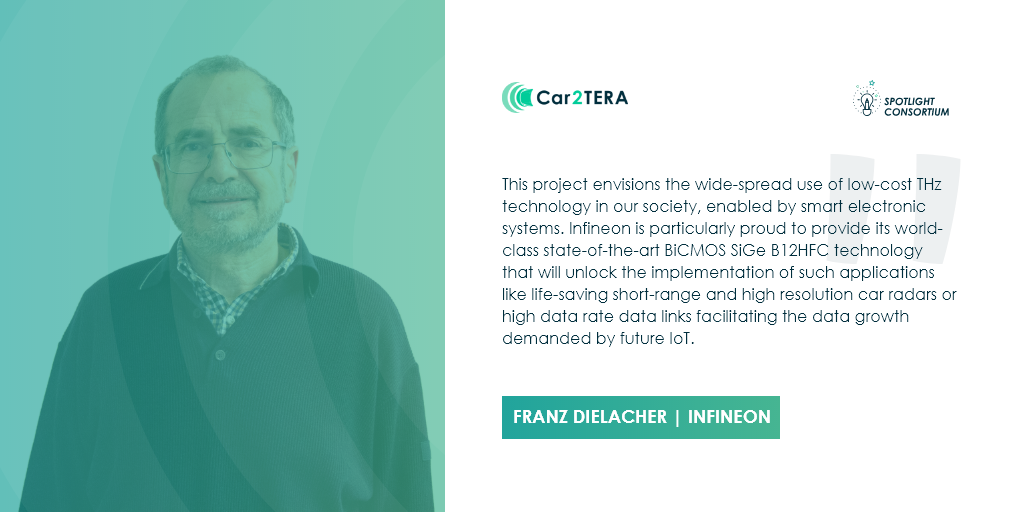Today in a talk with Franz Dielacher- 5 questions about himself and the Car2TERA H2020 project.
Introduce yourself and tell us a bit about your background.
My name is Franz Dielacher I received my M.S and PhD degrees in electrical engineering from the Graz University of Technology, Austria. My doctoral research was directed towards the modelling, simulation and design of oversampled analog-to-digital converters.
From 1981 until 1999 I worked for Siemens Semiconductor Group in circuit development and system integration for wireline and wireless communications. Since 1099 I am with Infineon Technologies in various positions in circuits and systems for communications like DSL, high-speed transceivers, and wireless infrastructure. Currently, I am a Senior Principal Engineer and Chief Scientist in the RF-Power Group.
My international involvement includes ISSCC TPC member from 2001 to 2011, ISSCC wireline sub-committee chair, ESSCIURC TPC member and TPC chair, ESSCIRC steering board member, ESSCIRC technical program committee chair, IEEE SSCS AdCOM member, since 2013 I am an IEEE SSCS Distinguished Lecturer and member of technical program committees for EUMIC, COMCAS and VLSI-TSA. I am also a technical advisor board member of the “CHIPS center of excellence” at KU Leuven and of the “ECIT” research center of Queen’s University Belfast.
What is your title and/or role in the project?
As the Impact Leader, I am responsible for ensuring that the project’s impact objectives are met with respect to the selected application fields and supervises the overall technical content in this regard. Hence, the Impact Leader assists the Scientific Leader and will be the chairman of the OEM group activities and the SME-User Group. New leadership can only be appointed by the General Assembly if necessary.
As a Work Package Leader, I am leading and coordinating the efforts in Work Package 1. Moreover, he will support as IFAT-representative in manufacturing specifications of high-volume manufacturability of SiGe ICs providing key technology parameters and constrains with respect to volume production.
What are your contributions to the project? (Specify what deliverables and/or tasks you are responsible for)
As representative in Car2TERA, I am responsible for:
- In WP1 “Requirement analysis, specifications and roadmap development”:
IFAT is leading and coordinating the efforts in . Moreover IFAT will support in manufacturing specifications of high-volume manufacturability of SiGe ICs providing key technology parameters and constrains with respect to volume production. - In WP2 “Multi-purpose, broadband, SiGe 600-GHz fMAX) circuits for THz sensor & communication applications”:
IFAT supplies the PDK and will be responsible for processing of SiGe BiCMOS integrated circuits and is also responsible for the following Deliverables. - In WP4 “Interfaces and packaging of new technologies into electronic systems”:
IFAT investigates the performance of eWLB packaging technology beyond 200 GHz. Provide appropriate models for parasitics. Develop and characterize microwave components. - In WP6 “Secondary demonstrator: wide-band THz-over-plastic links for short range intra-base station interconnect”:
IFAT supports the system integration activities by customizing IFAT’s advanced packaging eWLB solution to interface the SiGe MMICs with the system board. - In WP7 “Automotive System integration, System implications, Advanced processing & Sensor fusion”:
IFAT is monitoring the activities in WP and cooperate as WP1-Leader with the WP7 Task-Leaders to ensure the compliance of system integration selections to the results of the requirement analyses and system specifications provided by WP1. - In WP8 “Communication, Dissemination, Exploitation and Standardisation”:
IFAT is leading And promotes Car2TERA results through its industrial network, present it at all industrial events, conferences and workshops. IFAT is also in the leading position of the external User Group activities and patent investigations. - In WP9 “Project, Risk, and Innovation Management”:
IFAT is contributing/support in administrative tasks.
What challenges can you foresee in the project?
Major issues are related to the so called terahertz gap. Therefore a major challenge will be to push and to achieve appropriate and sufficient output power with good efficiency in the transmitters.
How do you think the project outcome could affect our daily life?
Further improved capabilities in telecommunications like massive broadband, massive machine-type and critical machine-type communications. In the sensing area terahertz frequencies and wide bandwidth will be the basis for significant improvements in terms of resolution of existing sensors like car radar and it will also enable new applications in spectroscopy, health monitoring and earth observation.
